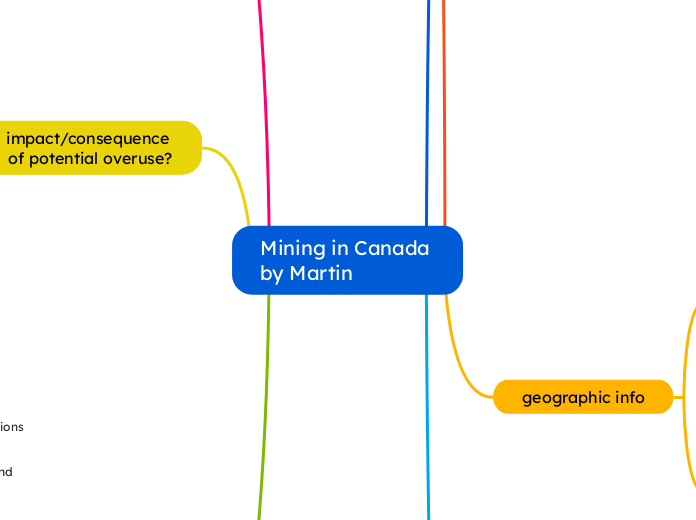Mining in Canada by Martin
general info
Canada mines 60 different minerals and metals from around 200 mines and 6500 quarries, such as gold, iron ore, cobalt, nickel, graphite, copper, potash, zink, aluminium and coal. https://www.canadaaction.ca/mining_sector_canada_by_the_numbers
Mining Industry in Canada is regulated by federal, provincial, and territorial government. Provintial and territorial government regulate exploration and extraction of miniral and metals. Federal government regulates foreign investment. And all three overlook of the impact of mining on the environment and taxation.
Mining contributed $125 billion to the GDP in 2021.
Canadian mining industry represented by Mining Association of Canada. Provides 263,000 indirect jobs, 403,000 direct jobs.
The equipment which is used in mining usually is very big. Some of them are diggers, loaders, and trucks. They are used to excavate raw materials, load, and transfer them from different types of mines and quarries to the surface and to the processing factories.
Main topic
geographic info
Mines and quarries are locatated in every province and territory of Canada. For example, gold is extracted in British Columbia, Quebec, Manitoba, Ontario, Nova Scotia, Yukon, and Nunavut.
Coal is extracted British Columbia, Alberta, and Nova Scotia.
Many other minerals and metals are extracted throughout of Canada and significantly contribute to the economic development.
impact of climate change
The Canadian mining sector faces various effects of climate change:
Physical effect:
Remote and challenging locations affected by changing climate conditions such as extreme weather, limited access to water, food, and other resources
Occupational health and safety risk
Transportation (bringing workers, equipment, supplies, and minerals to the market)
Rising sea levels (damaged roads, ports and other transport infrastructure)

The world’s move towards low-carbon economies, affecting the mining industry.
Transition risk:
Changing political, social, and consumer perceptions of high GHG (half global GHG emission) emitting and polluting industries.
Changing regulatory and legal framework
Regional security concern
Litigation and investigation, legal issues, and existing and future lawsuits
Under the 2015 Paris Agreement, 195 countries pledged to limit global warming to well below 2.0°C, and ideally not more than 1.5°C above pre industrial levels
That target, if pursued, would manifest in decarbonization across industries, creating major shifts in commodity demand for the mining industry and likely resulting in declining global mining revenue pools.
What should be done to protect the environment and the industry in particular
The regulations may be one of the solutions to protect the environment. However, with moving to low-carbon schemas, the mining industry might not be able to keep up with the regulations and will affect the prices for consumers.
The regulations or control would be a great solution for creating a safer use of other resources such as water, land and air while mining minerals and metals.
impact/consequence of potential overuse?
The overuse of natural resources, in general, affect our future generations and have a potential to leave other generations without resources to exist.
Canada mines coal which is not a renewable resource.
Moreover, the extraction of minerals affect land, water, and air.
Resources overuse harms health of ecosystem and human's wellbeing. Mining industry causes high polution level of land, water, and air.
impact on Indigenous people and their communities?
Rapid change to the communities' functions
Legal disputes
Environmental degradation
Changes in the ways people use their land
Increased mental stress
Loss of culture
Strangers in the community
Noise from machinery
Traffic from mining
Exposure to toxic materials
Higher chance of natural disasters
However, there is also a positive impact on indigenous community such as access access to jobs and wages, improved life style, and access to goods and variety of foods.
Some communities were faced with environmental contamination when they were left with 237,000 tonnes of arsenic after mines were abandoned.
